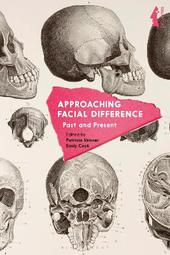
|
Approaching Facial Difference: Past and Present
Hardback
Main Details
| Title |
Approaching Facial Difference: Past and Present
|
| Authors and Contributors |
Edited by Patricia Skinner
|
|
Edited by Emily Cock
|
| Series | Facialities: Interdisciplinary Approaches to the Human Face |
|---|
| Physical Properties |
| Format:Hardback | | Pages:264 | | Dimensions(mm): Height 234,Width 156 |
|
| ISBN/Barcode |
9781350028296
|
| Classifications | Dewey:306.461 |
|---|
| Audience | | Tertiary Education (US: College) | |
|---|
| Illustrations |
15 bw illus
|
|
Publishing Details |
| Publisher |
Bloomsbury Publishing PLC
|
| Imprint |
Bloomsbury Academic
|
| Publication Date |
3 May 2018 |
| Publication Country |
United Kingdom
|
Description
What is a face and how does it relate to personhood? Approaching Facial Difference: Past and Present offers an interdisciplinary exploration of the many ways in which faces have been represented in the past and present, focusing on the issue of facial difference and disfigurement read in the light of shifting ideas of beauty and ugliness. Faces are central to all human social interactions, yet their study has been much overlooked by disability scholars and historians of medicine alike. By examining the main linguistic, visual and material approaches to the face from antiquity to contemporary times, contributors place facial diversity at the heart of our historical and cultural narratives. This cutting-edge collection of essays will be an invaluable resource for humanities scholars working across history, literature and visual culture, as well as modern practitioners in education and psychology.
Author Biography
Patricia Skinner is Research Professor in History at Swansea University, UK. She is also co-editor of Social History of Medicine. Emily Cock is Honorary Research Fellow in the Centre for Medieval and Early Modern Research at Swansea University, UK.
ReviewsThis extraordinary collection of essays reveals the ways in which the intersections of gender, cultural notions of beauty and wholeness, and physical difference articulate how people in the West respond to human faces. By explicating the relationship between facial difference and notions of moral soundness, disease, and anxiety-and its apparent continuity throughout the whole of European history-the editors and contributors challenge readers and researchers to re-evaluate modern-day assumptions about beauty and difference based upon their presentation of the past. * Linda E. Mitchell, Professor of History, University of Missouri-Kansas City, USA * This engaging multi-disciplinary study encourages us to 'look' at the face and its multiple facets from a variety of points of view. It is a much-needed first step in gaining a better, more holistic understanding of the face and its perceptions throughout time. * Marjorie Gehrhardt, Lecturer in French History, University of Reading, UK *
|